Enhancing Circular Polarization Performance of Low-Profile Patch Antennas for Wearables Using Characteristic Mode Analysis
Abstract
1. Introduction
2. Antenna Configuration
3. Working Mechanism
3.1. Characteristic Mode (CM) Theory
3.2. Characteristic Mode Analysis (CMA) of the Low-Profile CP Antenna
3.3. Full-Wave Simulation
4. Measurement and Discussion
4.1. Reflection Coefficient
4.2. Axial Ratio
4.3. Radiation Pattern and FBR
5. Conclusions
Author Contributions
Funding
Institutional Review Board Statement
Informed Consent Statement
Data Availability Statement
Conflicts of Interest
References
- Sharma, M.; Parini, C.G. A miniature wideband antenna for wearable systems. In Proceedings of the 2013 Loughborough Antennas and Propagation Conference, Loughborough, UK, 11–12 November 2013; pp. 619–623. [Google Scholar] [CrossRef]
- Rao, S.; Llombart, N.; Moradi, E.; Koski, K.; Bjorninen, T.; Sydanheimo, L.; Rabaey, J.M.; Carmena, J.M.; Rahmat-Samii, Y.; Ukkonen, L. Miniature implantable and wearable on-body antennas: Towards the new era of wireless body-centric systems [antenna applications corner]. IEEE Antennas Propag. Mag. 2014, 56, 271–291. [Google Scholar] [CrossRef]
- Harrington, R.F. Effect of antenna size on gain, bandwidth, and efficiency. J. Res. Natl. Bur. Stand. Sect. D Radio Propag. 1960, 64, 1–12. [Google Scholar] [CrossRef]
- Yan, S.; Soh, P.J.; Vandenbosch, G.A.E. Low-Profile Dual-Band Textile Antenna with Artificial Magnetic Conductor Plane. IEEE Trans. Antennas Propag. 2014, 62, 6487–6490. [Google Scholar] [CrossRef]
- Zhang, J.; Yan, S.; Vandenbosch, G.A.E. A Miniature Feeding Network for Aperture-Coupled Wearable Antennas. IEEE Trans. Antennas Propag. 2017, 65, 2650–2654. [Google Scholar] [CrossRef]
- Wagih, M.; Weddell, A.S.; Beeby, S. Omnidirectional Dual-Polarized Low-Profile Textile Rectenna with Over 50% Efficiency for Sub-μW/cm2 Wearable Power Harvesting. IEEE Trans. Antennas Propag. 2021, 69, 2522–2536. [Google Scholar] [CrossRef]
- Khaleel, H.R.; Al-Rizzo, H.M.; Rucker, D.G.; Mohan, S. A Compact Polyimide-Based UWB Antenna for Flexible Electronics. IEEE Antennas Wirel. Propag. Lett. 2012, 11, 564–567. [Google Scholar] [CrossRef]
- Jiang, Z.H.; Cui, Z.; Yue, T.; Zhu, Y.; Werner, D.H. Compact, Highly Efficient, and Fully Flexible Circularly Polarized Antenna Enabled by Silver Nanowires for Wireless Body-Area Networks. IEEE Trans. Biomed. Circuits Syst. 2017, 11, 920–932. [Google Scholar] [CrossRef]
- Zhang, S.; Zhu, J.; Zhang, Y.; Chen, Z.; Song, C.; Li, J.; Yi, N.; Qiu, D.; Guo, K.; Zhang, C.; et al. Standalone stretchable RF systems based on asymmetric 3D microstrip antennas with on-body wireless communication and energy harvesting. Nano Energy 2022, 96, 107069. [Google Scholar] [CrossRef]
- Sayem, A.S.M.; Lalbakhsh, A.; Esselle, K.P.; Buckley, J.L.; O’Flynn, B.; Simorangkir, R.B.V.B. Flexible Transparent Antennas: Advancements, Challenges, and Prospects. IEEE Open J. Antennas Propag. 2022, 3, 1109–1133. [Google Scholar] [CrossRef]
- Kaivanto, E.K.; Berg, M.; Salonen, E.; de Maagt, P. Wearable Circularly Polarized Antenna for Personal Satellite Communication and Navigation. IEEE Trans. Antennas Propag. 2011, 59, 4490–4496. [Google Scholar] [CrossRef]
- Hu, X.; Yan, S.; Zhang, J.; Volskiy, V.; Vandenbosch, G.A.E. Omni-Directional Circularly Polarized Button Antenna for 5 GHz WBAN Applications. IEEE Trans. Antennas Propag. 2021, 69, 5054–5059. [Google Scholar] [CrossRef]
- Yang, W.; Zhou, J.; Yu, Z.; Li, L. Single-Fed Low Profile Broadband Circularly Polarized Stacked Patch Antenna. IEEE Trans. Antennas Propag. 2014, 62, 5406–5410. [Google Scholar] [CrossRef]
- Hu, W.; Tang, Z.-Y.; Fei, P.; Yin, Y.-Z. Broadband circularly polarized Z-shaped dipole antenna with parasitic strips. Int. J. RF Microw. Comput. Eng. 2015, 27, e21052. [Google Scholar] [CrossRef]
- Ray, M.K.; Mandal, K.; Nasimuddin, N.; Lalbakhsh, A.; Raad, R.; Tubbal, F. Two-Pair Slots Inserted CP Patch Antenna for Wide Axial Ratio Beamwidth. IEEE Access 2020, 8, 223316–223324. [Google Scholar] [CrossRef]
- Sayem, A.S.M.; Simorangkir, R.B.V.B.; Esselle, K.P.; Lalbakhsh, A.; Gawade, D.R.; O’Flynn, B.; Buckley, J.L. Flexible and Transparent Circularly Polarized Patch Antenna for Reliable Unobtrusive Wearable Wireless Communications. Sensors 2022, 22, 1276. [Google Scholar] [CrossRef]
- Chen, Y.; Liu, X.; Fan, Y.; Yang, H. Wearable Wideband Circularly Polarized Array Antenna for Off-Body Applications. IEEE Antennas Wirel. Propag. Lett. 2022, 21, 1051–1055. [Google Scholar] [CrossRef]
- Yang, H.; Liu, X.; Fan, Y. Design of Broadband Circularly Polarized All-Textile Antenna and Its Conformal Array for Wearable Devices. IEEE Trans. Antennas Propag. 2022, 70, 209–220. [Google Scholar] [CrossRef]
- Yang, H.C.; Liu, X.Y.; Fan, Y.; Tentzeris, M.M. Flexible circularly polarized antenna with axial ratio bandwidth enhancement for off-body communications. IET Microw. Antennas Propag. 2021, 15, 754–767. [Google Scholar] [CrossRef]
- Moro, R.; Agneessens, S.; Rogier, H.; Bozzi, M. Circularly-polarised cavity-backed wearable antenna in SIW technology. IET Microw. Antennas Propag. 2018, 12, 127–131. [Google Scholar] [CrossRef]
- Hertleer, C.; Rogier, H.; Vallozzi, L.; Van Langenhove, L. A Textile Antenna for Off-Body Communication Integrated Into Protective Clothing for Firefighters. IEEE Trans. Antennas Propag. 2009, 57, 919–925. [Google Scholar] [CrossRef]
- Li, J.; Jiang, Y.; Zhao, X. Circularly Polarized Wearable Antenna Based on NinjaFlex-Embedded Conductive Fabric. Int. J. Antennas Propag. 2019, 2019, 3059480. [Google Scholar] [CrossRef]
- Row, J.-S.; Wu, S.-W. Circularly-Polarized Wide Slot Antenna Loaded With a Parasitic Patch. IEEE Trans. Antennas Propag. 2008, 56, 2826–2832. [Google Scholar] [CrossRef]
- Zhu, H.L.; Cheung, S.W.; Chung, K.L.; Yuk, T.I. Linear-to-Circular Polarization Conversion Using Metasurface. IEEE Trans. Antennas Propag. 2013, 61, 4615–4623. [Google Scholar] [CrossRef]
- Zheng, Q.; Guo, C.; Ding, J.; Akinsolu, M.O.; Liu, B.; Vandenbosch, G.A.E. A Wideband Low-RCS Metasurface-Inspired Circularly Polarized Slot Array Based on AI-Driven Antenna Design Optimization Algorithm. IEEE Trans. Antennas Propag. 2022, 70, 8584–8589. [Google Scholar] [CrossRef]
- Lalbakhsh, A.; Afzal, M.U.; Hayat, T.; Esselle, K.P.; Mandal, K. All-metal wideband metasurface for near-field transformation of medium-to-high gain electromagnetic sources. Sci. Rep. 2021, 11, 9421. [Google Scholar] [CrossRef]
- Esfandiari, M.; Lalbakhsh, A.; Shehni, P.N.; Jarchi, S.; Ghaffari-Miab, M.; Mahtaj, H.N.; Reisenfeld, S.; Alibakhshikenari, M.; Koziel, S.; Szczepanski, S. Recent and emerging applications of Graphene-based metamaterials in electromagnetics. Mater. Des. 2022, 221, 110920. [Google Scholar] [CrossRef]
- Lalbakhsh, A.; Afzal, M.U.; Esselle, K.P.; Smith, S.L. All-Metal Wideband Frequency-Selective Surface Bandpass Filter for TE and TM Polarizations. IEEE Trans. Antennas Propag. 2022, 70, 2790–2800. [Google Scholar] [CrossRef]
- Fu, S.; Kong, Q.; Fang, S.; Wang, Z. Broadband Circularly Polarized Microstrip Antenna with Coplanar Parasitic Ring Slot Patch for L-Band Satellite System Application. IEEE Antennas Wirel. Propag. Lett. 2014, 13, 943–946. [Google Scholar] [CrossRef]
- Feng, D.; Zhai, H.; Xi, L.; Yang, S.; Zhang, K.; Yang, D. A Broadband Low-profile Circular Polarized Antenna on an AMC Reflector. IEEE Antennas Wirel. Propag. Lett. 2017, 16, 2840–2843. [Google Scholar] [CrossRef]
- Lalbakhsh, A.; Afzal, M.; Esselle, K.; Smith, S. A High-gain Wideband EBG Resonator Antenna for 60 GHz Unlicenced Frequency Band. In Proceedings of the 12th European Conference on Antennas and Propagation (EuCAP 2018), London, UK, 9–13 April 2018. [Google Scholar] [CrossRef]
- Lalbakhsh, A.; Simorangkir, R.B.; Bayat-Makou, N.; Kishk, A.A.; Esselle, K.P. Artificial Intelligence and Data Science in Environmental Sensing; Academic Press: Cambridge, MA, USA, 2022. [Google Scholar] [CrossRef]
- Chaudhary, P.; Kumar, A. Compact ultra-wideband circularly polarized CPW-fed monopole antenna. AEU Int. J. Electron. Commun. 2019, 107, 137–145. [Google Scholar] [CrossRef]
- Harrington, R.; Mautz, J. Theory of characteristic modes for conducting bodies. IEEE Trans. Antennas Propag. 1971, 19, 622–628. [Google Scholar] [CrossRef]
- Yikai, C.; Chao-Fu, W. Characteristic Modes: Theory and Applications in Antenna Engineering; Wiley: Hoboken, NJ, USA, 2015. [Google Scholar]
- Sharma, P.; Gupta, K. Analysis and optimized design of single feed circularly polarized microstrip antennas. IEEE Trans. Antennas Propag. 1983, 31, 949–955. [Google Scholar] [CrossRef]
- Gemio, J.; Parron, J.; Soler, J. Human body effects on implantable antennas for ism bands applications: Models comparison and propagation losses study. Prog. Electromagn. Res. 2010, 110, 437–452. [Google Scholar] [CrossRef]
- Soh, P.J.; Vandenbosch, G.A.E.; Wee, F.H.; van den Bosch, A.; Martinez-Vazquez, M.; Schreurs, D.M.M.P. Specific Absorption Rate (SAR) evaluation of biomedical telemetry textile antennas. In Proceedings of the 2013 IEEE MTT-S International Microwave Symposium Digest (MTT), Seattle, WA, USA, 2–7 June 2013. [Google Scholar] [CrossRef]
- Microwave Studio. Computer Simulation Technology (CST). 2020. Available online: https://www.3ds.com/products-services/simulia/products/cst-studio-suite/ (accessed on 21 February 2023).
- 7 SAR Tissue Ingredients. Available online: https://fcc.report/FCC-ID/ACJ9TGWL16B/3754300.pdf (accessed on 19 December 2022).
- Balanis, C.A. Antenna Theory: Analysis and Design; John Wiley & Sons: Hoboken, NJ, USA, 2016. [Google Scholar]
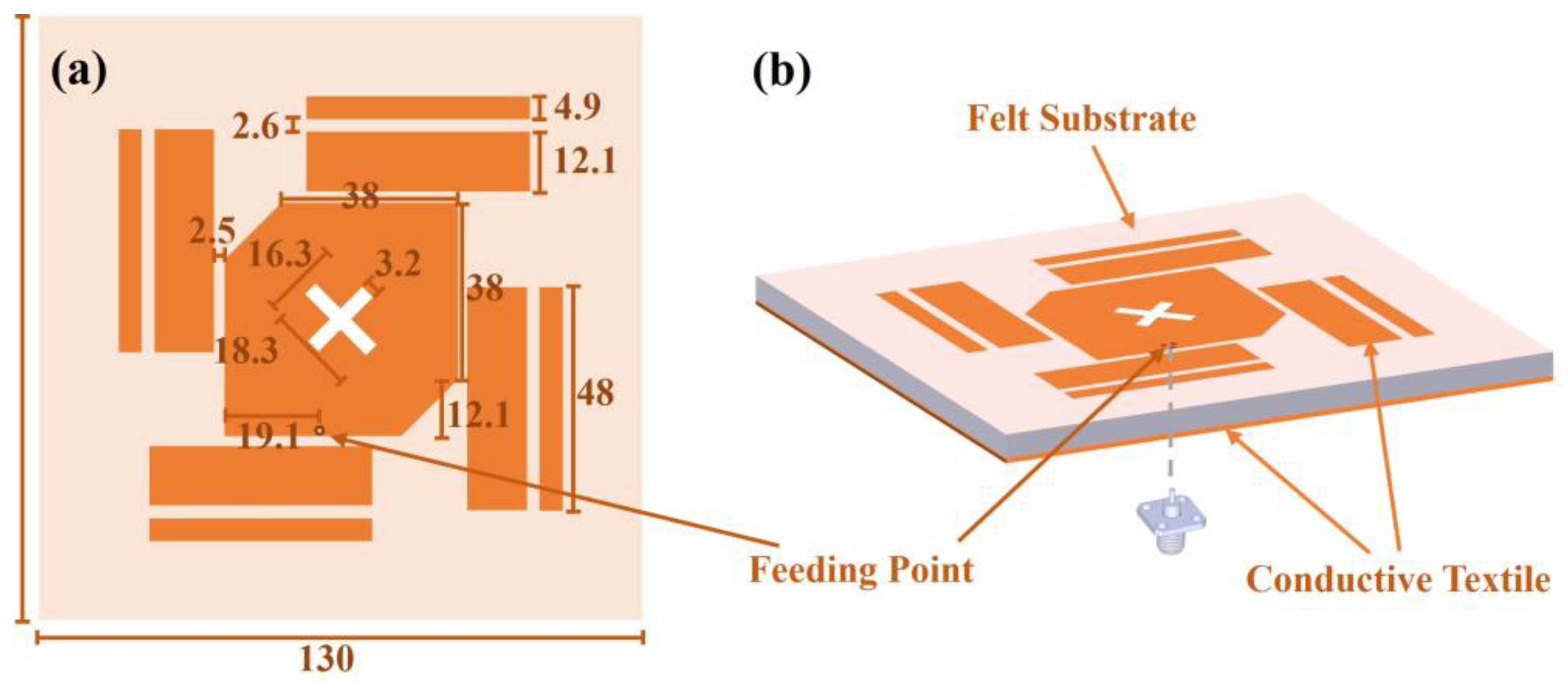


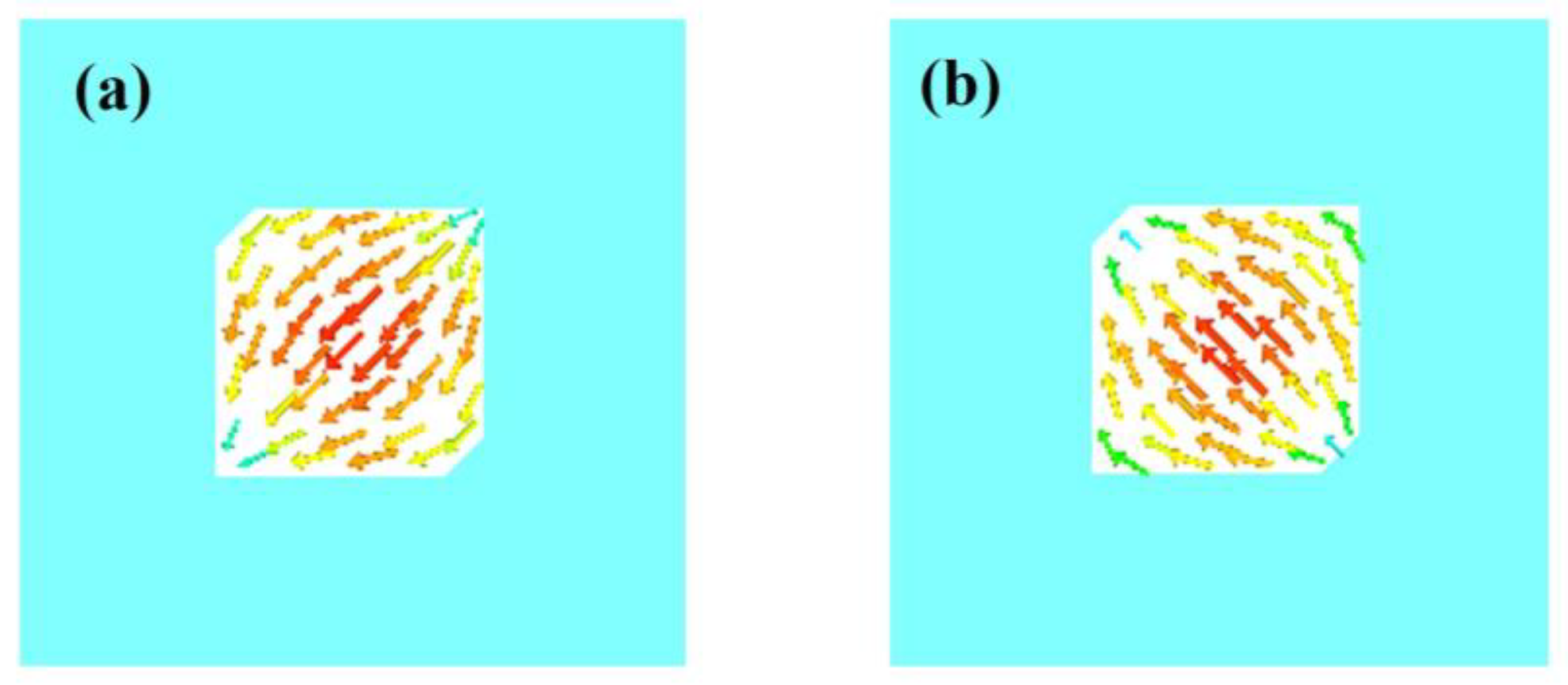
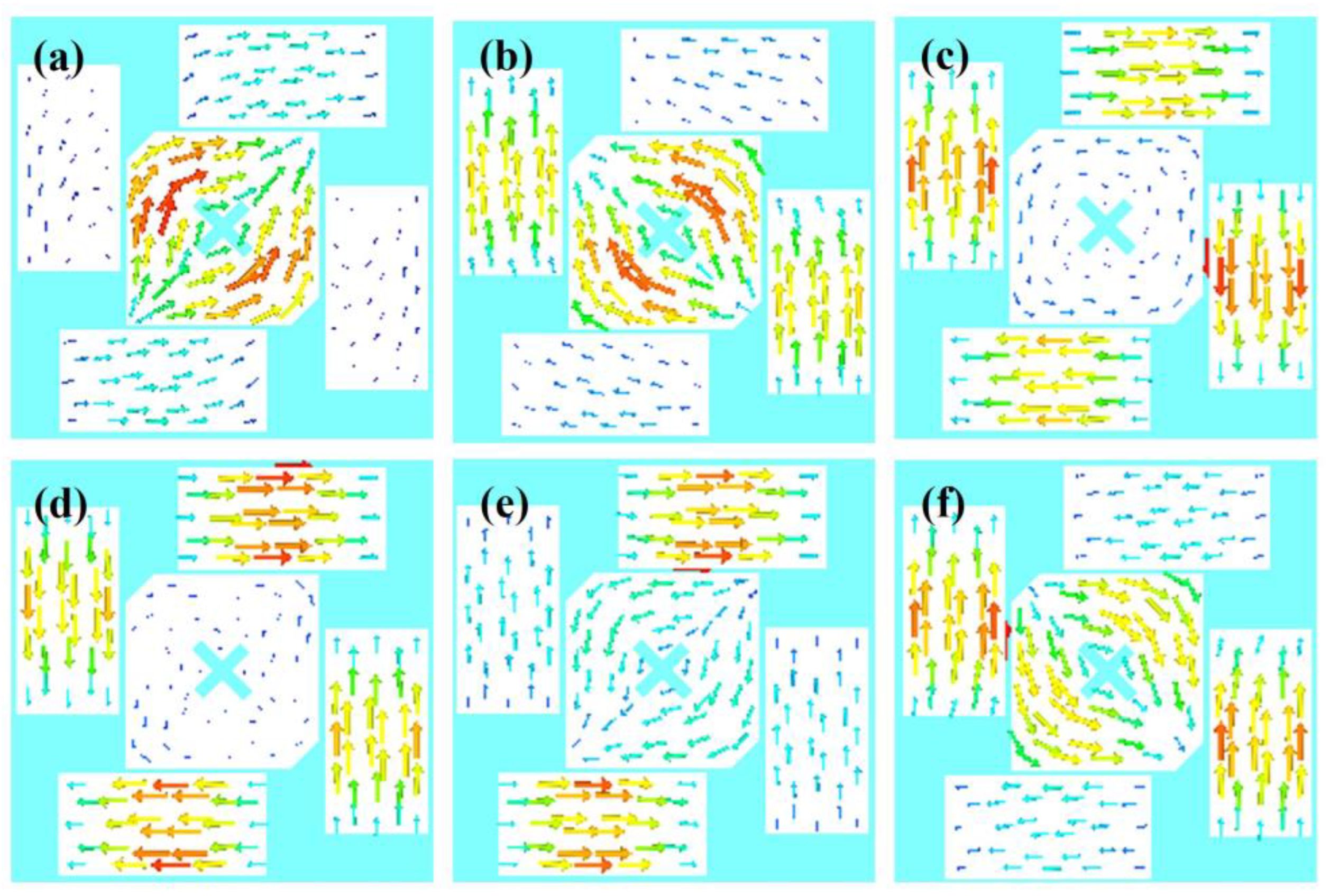
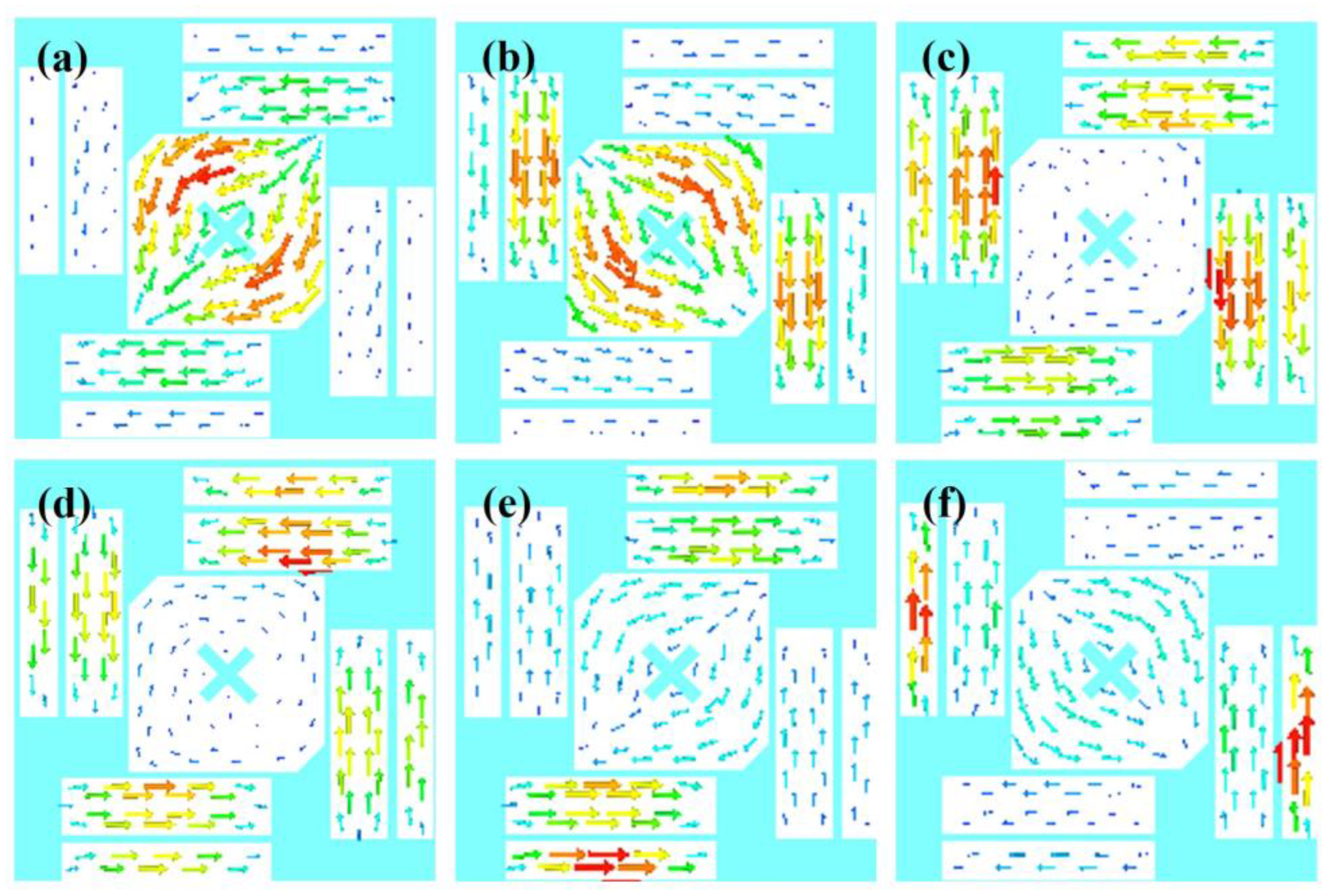
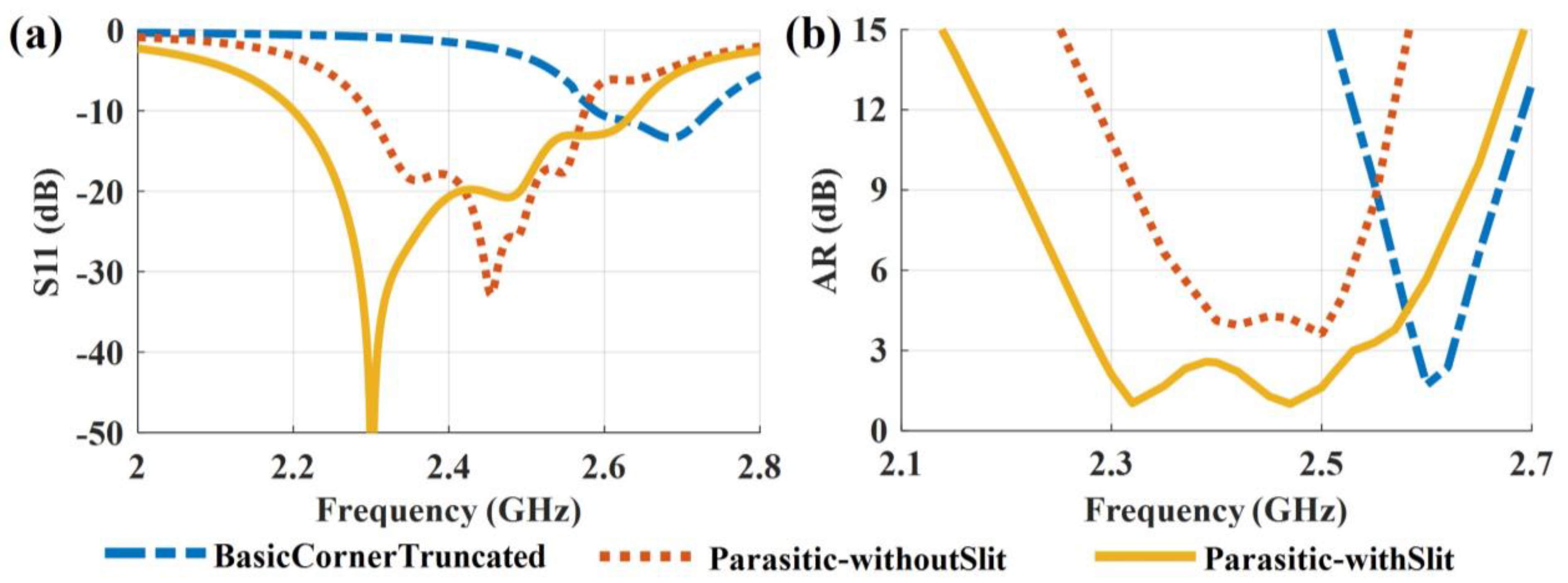
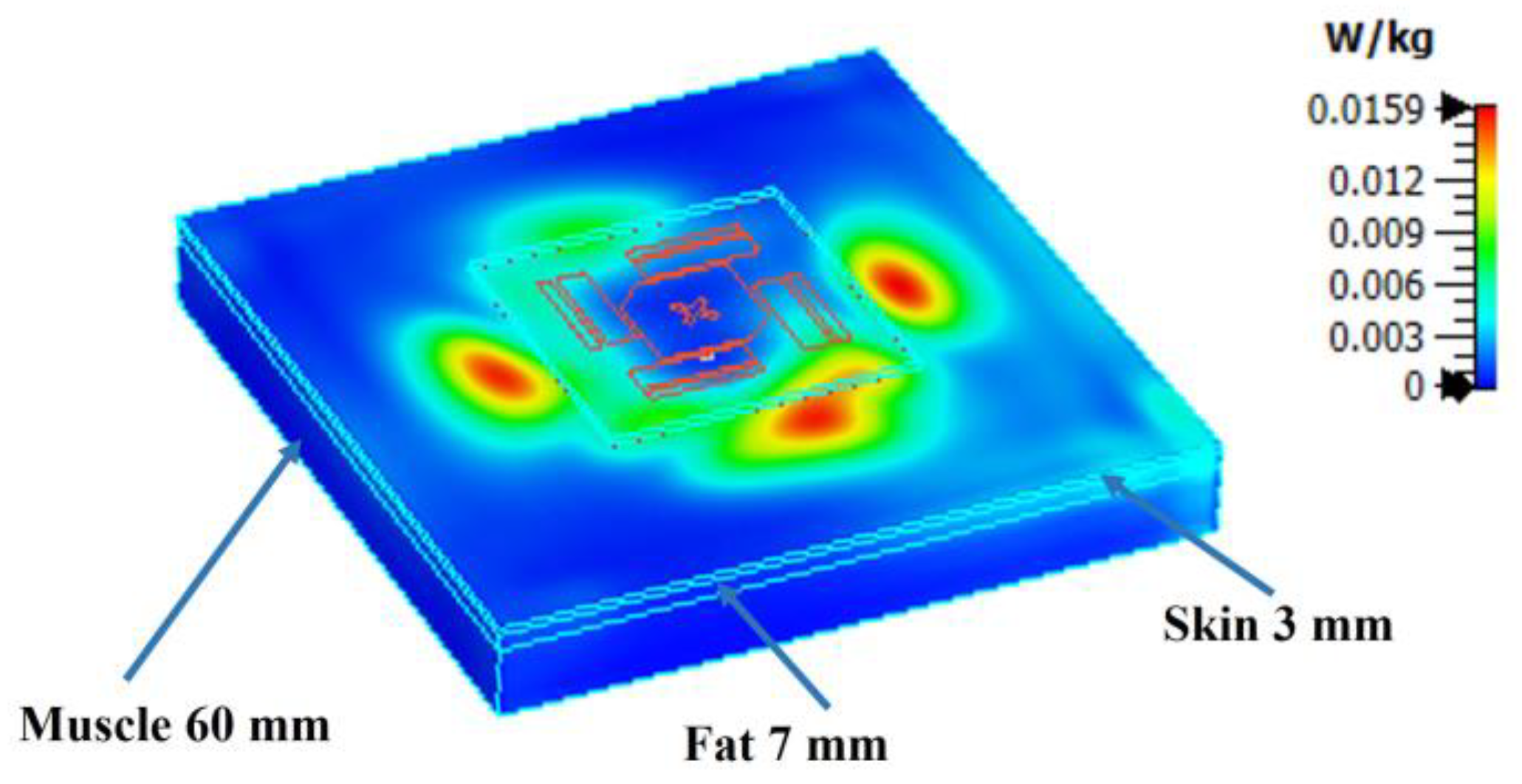

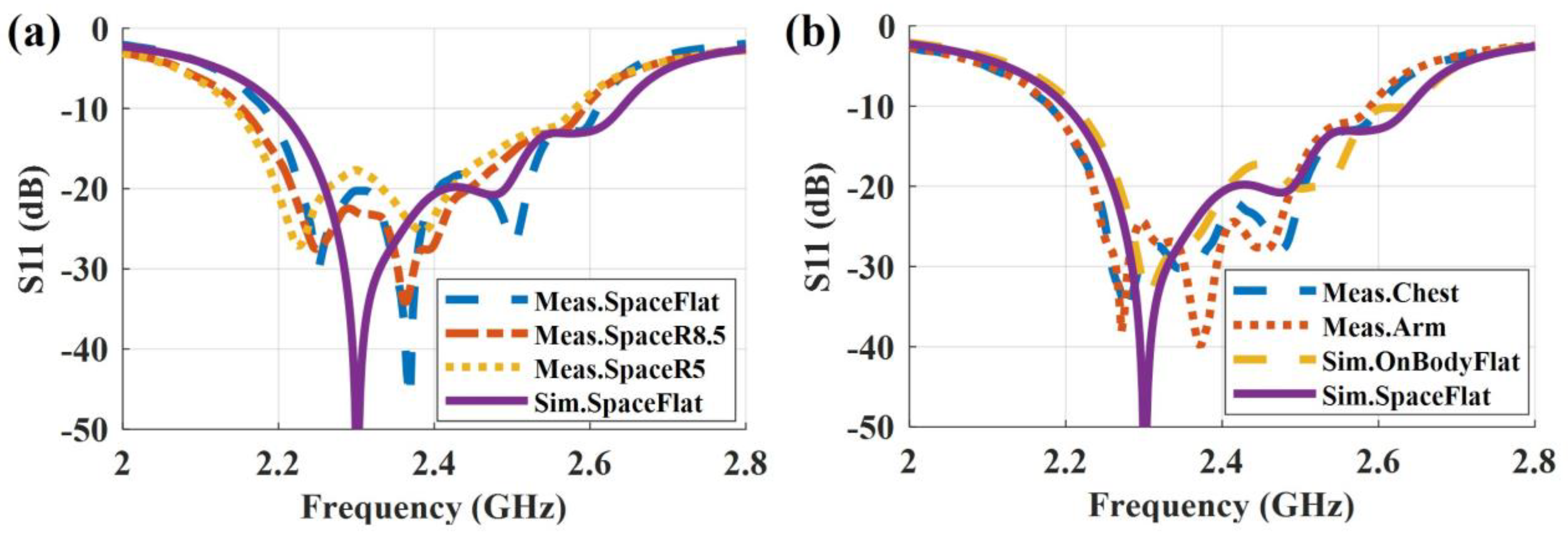

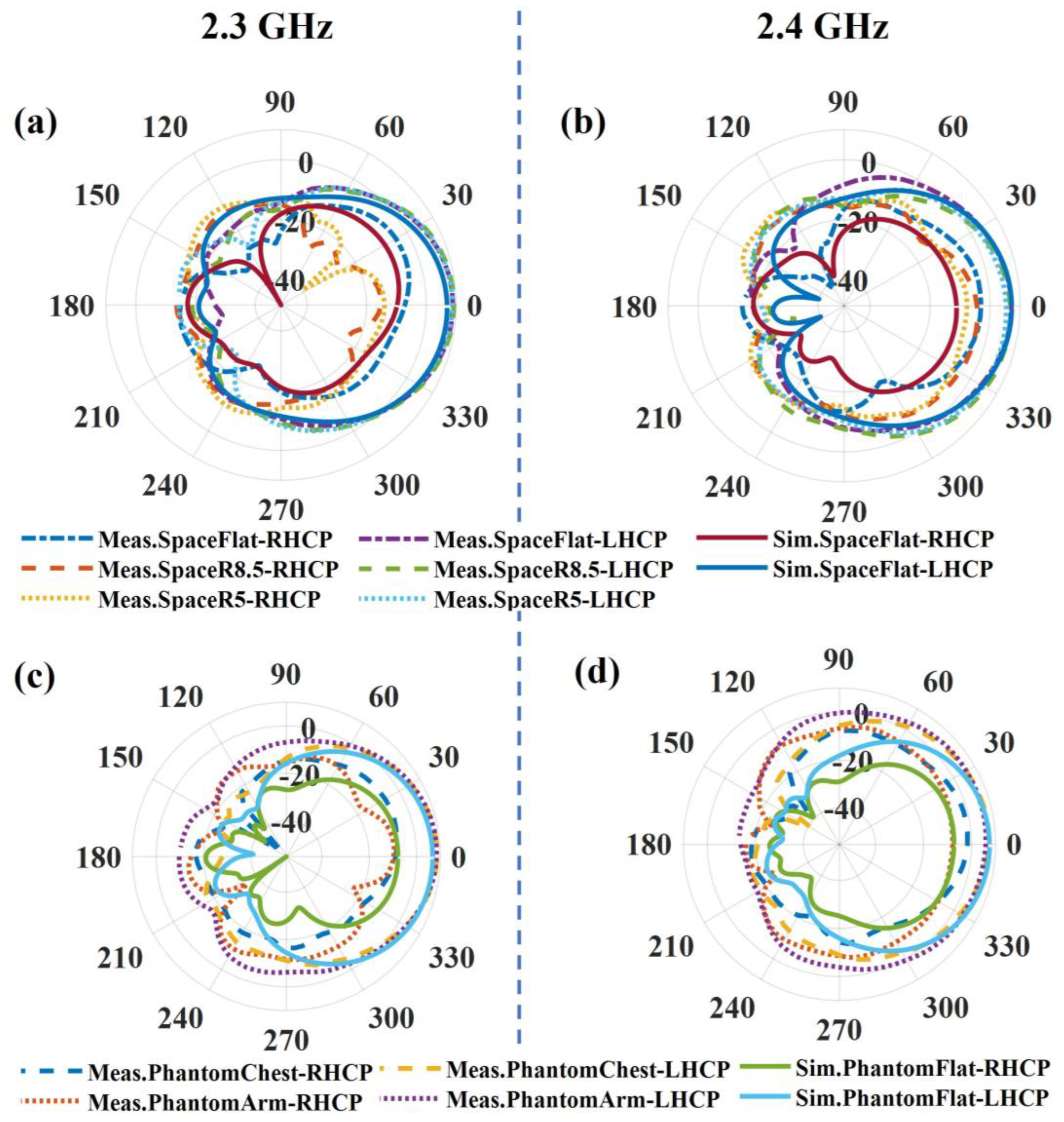
| Ref. | f0 (GHz) | Size (mm3, | Impedance BW (GHz) | 3-dB AR BW(GHz) | Peak Gain | Efficiency | FBR (dB) | Wearable Material |
|---|---|---|---|---|---|---|---|---|
| [12] | 5.8 | 14.1 × 14.1 × 10.29, 0.273 × 0.273 × 0.199 | 5.68–5.91 3.97% | 5.72–5.89 2.93% | 2.1 dBic | 72.6% | NA | Yes |
| [13] | 6 | 40 × 40 × 4.5, 0.8 × 0.8 × 0.09 | 5.0–7.0 33% | 5.38–6.62 20.7% | 8.6 dBic | NA | 20 * | No, rigid |
| [14] | 2.49 | 130 × 130 × 15, 1.079 × 1.079 × 0.125 | 1.87–3.11 49.8% | 2.32–2.95 24% | 8.7 dBic | NA | 25 * | No, rigid |
| [17] | 5.44 | 40 × 40 × 4, 0.725 × 0.725 × 0.072 | 4.25–6.63 43% | 4.71–6.67 34% | 7.5 dBic | NA | 30 * | Yes |
| [18] | 5.47 | 54 × 54 × 4.4, 0.985 × 0.985 × 0.080 | 4.51–6.43 35.1% | 5.02–5.98 17.5% | 8.5 dBic | 77% | 35 * | Yes |
| [19] | 5.86 | 35 × 35 × 2.24, 0.684 × 0.684 × 0.044 | 5.67–6.05 6.6% | 5.73–5.955 3.85% | 7.2 dBic | NA | 28 * | Yes |
| [20] | 2.43 | 65.6 × 58.9 × 3.94, 0.531 × 0.477 × 0.032 | 2.26–2.6 * 14.0% | 2.365–2.499 5.5% | 6.5 dBic | 73% | 25 * | Yes |
| [21] | 2.45 | 100 × 100 × 3.94, 0.818 × 0.818 × 0.032 | 2.34–2.57 9.4% | 2.4–2.45 * 2.1% | 6 dBic | 62% | 30 * | Yes |
| [22] | 2.5 | 60 × 60 × 3, 0.5 × 0.5 × 0.025 | 2.36–2.64 11% | 2.42–2.49 2.86% | 1.8 dBic | 30.7% | 18 * | Yes |
| [16] | 2.45 | 60 × 60 × 3.4, 0.48 × 0.48 × 0.027 | 2.26–2.64 * 15.5% | 2.3–2.4 4.08% | 2.5 dBic | 42.26% | 25 * | Yes |
| This work | 2.4 | 130 × 130 × 3.34, 1.04 × 1.04 × 0.027 | 2.18–2.61 18% | 2.2–2.54 14.3% | 8.9 dBic | 52.96% | 35 | Yes |
Disclaimer/Publisher’s Note: The statements, opinions and data contained in all publications are solely those of the individual author(s) and contributor(s) and not of MDPI and/or the editor(s). MDPI and/or the editor(s) disclaim responsibility for any injury to people or property resulting from any ideas, methods, instructions or products referred to in the content. |
© 2023 by the authors. Licensee MDPI, Basel, Switzerland. This article is an open access article distributed under the terms and conditions of the Creative Commons Attribution (CC BY) license (https://creativecommons.org/licenses/by/4.0/).
Share and Cite
Chen, Z.; Zheng, X.; Song, C.; Zhang, J.; Volskiy, V.; Li, Y.; Vandenbosch, G.A.E. Enhancing Circular Polarization Performance of Low-Profile Patch Antennas for Wearables Using Characteristic Mode Analysis. Sensors 2023, 23, 2474. https://doi.org/10.3390/s23052474
Chen Z, Zheng X, Song C, Zhang J, Volskiy V, Li Y, Vandenbosch GAE. Enhancing Circular Polarization Performance of Low-Profile Patch Antennas for Wearables Using Characteristic Mode Analysis. Sensors. 2023; 23(5):2474. https://doi.org/10.3390/s23052474
Chicago/Turabian StyleChen, Zhensheng, Xuezhi Zheng, Chaoyun Song, Jiahao Zhang, Vladimir Volskiy, Yifan Li, and Guy A. E. Vandenbosch. 2023. "Enhancing Circular Polarization Performance of Low-Profile Patch Antennas for Wearables Using Characteristic Mode Analysis" Sensors 23, no. 5: 2474. https://doi.org/10.3390/s23052474
APA StyleChen, Z., Zheng, X., Song, C., Zhang, J., Volskiy, V., Li, Y., & Vandenbosch, G. A. E. (2023). Enhancing Circular Polarization Performance of Low-Profile Patch Antennas for Wearables Using Characteristic Mode Analysis. Sensors, 23(5), 2474. https://doi.org/10.3390/s23052474







